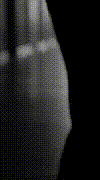I make my comix in a rather specialized way, relying on a sign-making computer program (Flexi-sign Pro) that will neither be easily accessible to most artists nor the software of choice for art applications. Therefore, most of what I have to say will be of academic, rather than practical, value.
My approach to page/panel layout is rather rudimentary and formalized. All my pages are horizontally oriented in a 3-to-4 ratio... the same dimensions as a TV or motion picture screen, prior to de facto widescreen. This fits the size requirements of the computer paper (typing paper, in the old days) that serves as my work medium; it fits my monitor dimensions rather neatly, too. I favor horizontal page orientation, as opposed to the more comix-traditional vertically oriented page, so as to eliminate the need for viewer scrolling. Paper comix pages are almost always viewed two at a time (the book open, pages spread), which amounts to a horizontal layout, regardless of individual page format. Since e-comix pages tend to be displayed individually, I find this longer orientation preferred.
Each page has a fixed four-panel division: the panels are oriented in a horizontal 3-to-4, same as the page. I strive for cinematic feel in my visuals, which this ratio accommodates quite nicely. The pair of upper or lower panels can be eliminated in favor of an extra long one (amounting to a cinematic pan shot), while the left or right pair can be jettisoned for an extra tall one (amounting to a camera tilt). For scenes that require great scope, the page can be taken up with a single large panel, filled with dramatic detail. These page/panel layouts pre-exist as templates in one of my Flexi-sign files. There are only six choices altogether: four panels, three panels (one, a tall panel), three panels (one, a wide panel), two panels (both tall), two panels (both wide), and one full-page panel. Of these, the two panel layouts are very rarely used; I rely on the four and three panel pages the most, with a full page panel often needed for the opening titles.
These page requirements are taken into account when I write the script, which always runs similar to this (from Chapter 18):
21/1. Tall panel: HA view, as the wagon breaks through into a rolling plain.
21/2. Fiona: This is it! The border of the Gloominvald! We're free at last! No more sprites, twisting trails or scanty horizons! It's fresh air and open roads from now on!
21/3. Feare: Patience, daughter. Don't be hasty... Miss Angie's yet to make her choice. You're welcome to travel with us to Bliss Harbor, child. Or free to return to Tabor County... Bandar-Thul is an expert guide and at your service. We'll not need his skills to reach the coast.
22/1. Bewildered Angie and eager Fiona.
22/2. Angie: Gosh... I dearly would love to see Daddy again. But... if it's all the same... if I may, I guess I will stay on. I'd hate to desert Fiona... I've come to love her, too. And she's taught me so terribly much! What a pity it would be to quit the lessons now!
22/3. Beaming Fiona, blushing Angie.
22/4. LS: on the hillside, a grazing manequi stares intently.
While scripting, attention is focused on dialogue rather than the upcoming graphics, as I have a good unspoken sense of what visuals I'll want (were I writing for another artist, the descriptions of action would be much more thorough). Storyboarding is the next step, and this is where initial visual concerns are addressed. I have a stored selection of storyboard templates, just as I do for the art pages. Below is an example of my thumbnail sketching. Note that it's extremely rushed and crude, scarcely better than stick-figure quality. These graphics are needed solely to work out spacial relationships, angles, close-ups vs. long shots, poses, and broad attitude; even then, they aren't adhered to religiously, so lavishing detailed attention on them is wasted effort.
It is vitally important to establish character placement, as the resulting word balloon placement depends on this. Once the storyboards are done, they guide the dialogue as it's typed into a page template within Flexi-sign Pro. A print is then made of the panels and wording: linework is added to the blank panels and around the text rather than vise versa, opposite to the way most comix artists approach the problem. This is necessary in the absence of a sophisticated imaging program, especially since my stories tend to be dialogue heavy. Raw linework is rescanned into Flexi-sign Pro so that it can be cleaned up; incoming images need to "vectorized" so that the program can manipulate them. Basically, vectorizing turns the lines into a series of connected dots; pulling on these dots will alter the shape of the image. This is useful for fixing irregular line thickness; eliminating extraneous lines (by erasing the dots); and, in very rare instances, redrawning detail. This last is not recommended for gross errors; one might just as well redraw the panel. Vectorizing does allow reworked art to be easily dropped in, however.
Once the linework has been streamlined to my satisfaction, block color can be added by grabbing the lines with the cursor and filling them in from Flexi-sign's pallet. Lines must be fully closed (no breaks between skin and clothing, for example) or bleed-through occurs. Pre-exisitng color selections are available, but I find most of them inadequate and prefer to wing it from the color wheel. This frequently leads to color inconsistency from page to page, as replicating a specific shade is always rough guesswork; any who've wondered why Sid's skintones vary wildly will now understand the reason.
With block coloring complete, a second print is made. Colored pencils are applied for highlights, shading, blending and special effects. This is the last step before scanning; all elements considered, a single page takes about a full day to complete. I don't work page by page, though; it proves more efficient to divide the labor into phases (scripting, storyboarding, dialogue fonts, linework, cleanup, gross color, detail color) and finish all the work in one phase before proceeding to the next. That's the ideal, but doing one thing exclusively for weeks can be highly monotonous; nowdays, I mix things up a bit more, working on lineart during the weekends (when I can devote a full day to it), while cleaning it up and adding color on weekdays (when I'm restricted to the evening hours). This schedule may have been completely rethought in a couple of months; even now, it's an evolving process.





